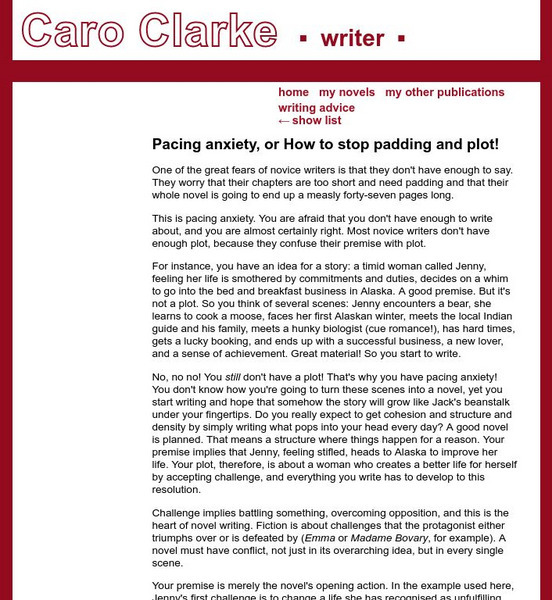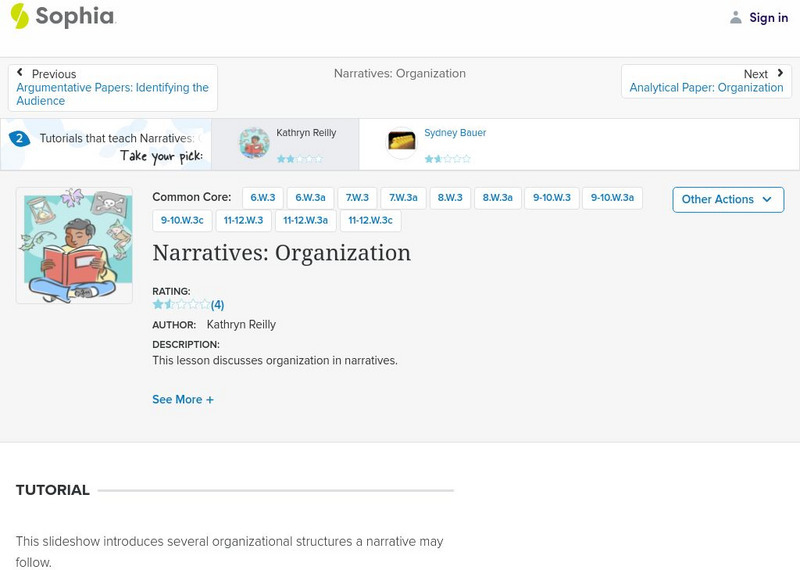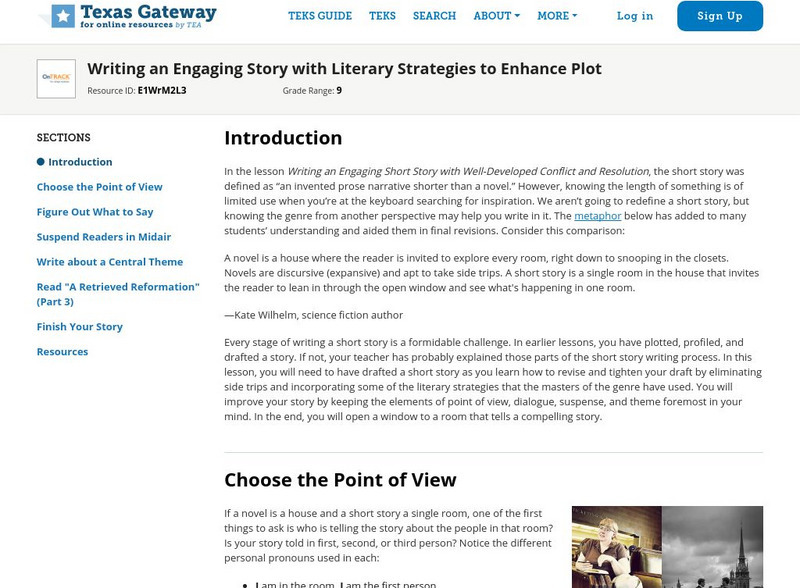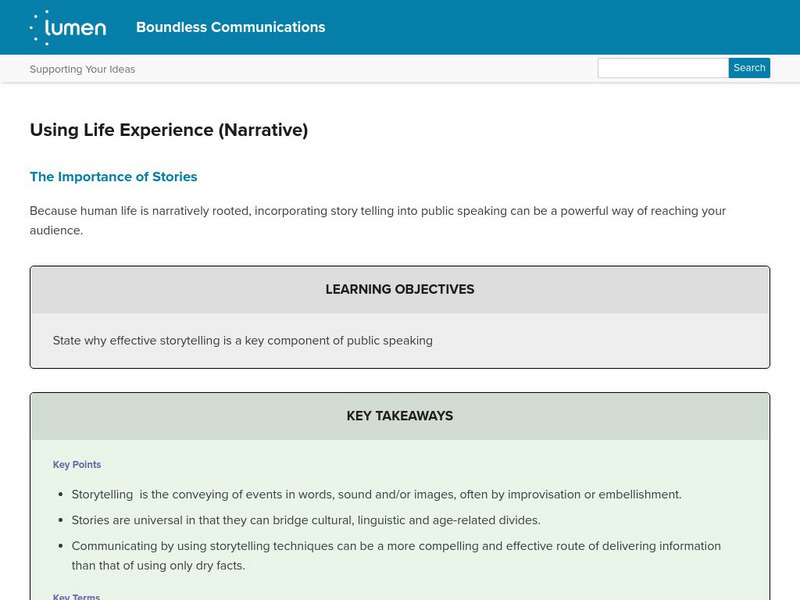Houghton Mifflin Harcourt
Holt, Rinehart and Winston: Elements of Literature: Narrator Chart [Pdf]
Provides an overview of the importance of a narrator in a text and some brief exercises for analysis. Helps students learn more about the role of the narrator in literature, his/her voice, and influence on other characters and events.
Writing Fix
Writing Fix: Counting Up or Down Stories
The writer will brainstorm situations where individuals or people in a group count up or count down out loud together. Using the ending of chapter 5 of Wringer by Jerry Spinelli as a model, the writer will plan a story where someone (or...
ReadWriteThink
Read Write Think: Exploring Perspective in Narrative
Interactive instructional activity which allows learners to determine the perspective or point of view of a story character by imagining actually spending a day in their "shoes." Based on Atticus's statement in "To Kill a Mockingbird."...
E Reading Worksheets
E Reading Worksheets: Narrative Essay Topics and Story Ideas
A collection of 101 narrative essay topics, short story ideas, and narrative writing prompts are provided on this site. Links to related narrative topics are also provided. W.11-12.3 Narratives, W.11-12.3a Narratives
Caro Clarke
Caro Clarke: What Is Conflict?
This is the sixth in a series of articles designed to help the new writer with their novel. This article focuses on conflict and how it effects the characters and the plot of the story. W.11-12.3a Narratives
Caro Clarke
Explaining Too Much: Why More Is Less
This is the eleventh article in a series that is designed to help the new novel author. This article focuses on how to eliminate needless information in your novel. The key is to not explain too much about the action.
Annenberg Foundation
Annenberg Learner: Workshop 2: Making Writing Meaningful
Workshop 2 demonstrates how teachers use authentic sources and topics to prompt students to write about things that matter to them, subjects that relate to their lives, relationships, and communities. The topic may be the students -...
Annenberg Foundation
Annenberg Learner: Literature: Exploring Point of View
Use these brief explanations to help you determine the narrator and point of view in any piece of literature. W.11-12.3a Narratives
ReadWriteThink
Read Write Think: Conflict Map
This graphic organizer focuses on conflict: identifying the conflict, listing possible resolutions, and determining the cause of the conflict. It can be used as a reading tool, a writing organizer, or solving a real-life conflict.
Caro Clarke
Caro Clarke: Pacing Anxiety, or How to Stop Padding and Plot!
This is the seventh installment of a series giving advice to the author who is new to writing novels. This article focuses on how to take your characters and use them and their conflicts to develop the plot of your story. W.9-10.3b...
ReadWriteThink
Read Write Think: Making Connections to Myth and Folktale
Excellent online lesson based on N. Scott Momaday's The Way to Rainy Mountain. Students create a three-voice narrative based on the novel in studying and learning about myths and folktales. W.9-10.3a,3b,3d,3e Narratives, W.9-10.5 Writing...
Houghton Mifflin Harcourt
Holt, Rinehart and Winston: Writer's Model: High School Personal Narrative Example
This two-page essay provides an example of a personal narrative (Click on View Printable Version). Clicking on the "Writer's Guide" link in the upper right-hand corner of the page enables the user to get tips, directions, and...
Sophia Learning
Sophia: Narratives: Organization
This slideshow lesson focuses on organizational structures for narratives including a review of narratives and a list of possible organizational structure types: chronological or sequential order, climactic order, in media, and...
Sophia Learning
Sophia: Writing Narratives
Notes, a PowerPoint presentation, two videos, a song, an exercise, and a game help students to understand how to write a narrative. Elements of a narrative as well as the use of figurative language and sensory images are introduced and...
Sophia Learning
Sophia: Audience and Writing Style
This slideshow tutorial focuses on adjusting writing style to fit the audience. It looks at audience characteristics and discusses how to adapt the vocabulary, sentence style, and tone to fit them. It provides an example using the topic...
Other
Storytelling in the Classroom
There are several steps to becoming a storyteller. Find out what they are and be on your way to becoming a storyteller here! Learn how to find good stories to tell, and how to tell them to an audience effectively.
Texas Education Agency
Texas Gateway: Analyze Linear Plot Developments in Literary Texts/fiction
[Accessible by TX Educators. Free Registration/Login Required] You will learn how to use the elements of linear plot development to determine whether and how conflicts are resolved.
Texas Education Agency
Texas Gateway: Writing Engaging Stories With Literary Strategies to Enhance Plot
Use various literary strategies and devices, including dialogue and suspense, to enhance the plot in a short story.
Lumen Learning
Lumen: Boundless Communications: Using Life Experience (Narrative)
This lesson focuses on using narratives or stories in speeches. It discusses the importance of stories, the power of storytelling, and how and when to use stories in speeches.
Lumen Learning
Lumen: Boundless Communications: Introduction
This lesson focuses on the introduction to your speech. It includes the role of the introduction, strategies for the opening, getting attention and interest, establishing credibility, self-presentation, and introducing the topic, thesis,...
Lumen Learning
Lumen: Writing Process: Selecting a Topic
This lesson focuses on selecting a writing topic including your approach to the assignment, understanding the assignment, purpose of the assignment, strategies for finding a topic, and how to narrow a topic to fit the scope and purpose...
Lumen Learning
Lumen: Writing Skills: Introductions
This lesson focuses on identifying and evaluating strategies for writing introductions.
Lumen Learning
Lumen: Reading and Interpreting Literary Texts: How to Analyze a Short Story
This lesson focuses on analyzing a short story including all of the elements of a short story such as setting, plot and structure, and characterization.
Texas Education Agency
Texas Gateway: Characters and Staging in Drama
[Accessible by TX Educators. Free Registration/Login Required] In this lesson, you will analyze how different playwrights characterize, or develop, their protagonists and antagonists through the dialogue and staging of their plays.


![Holt, Rinehart and Winston: Elements of Literature: Narrator Chart [Pdf] Graphic Holt, Rinehart and Winston: Elements of Literature: Narrator Chart [Pdf] Graphic](http://content.lessonplanet.com/resources/thumbnails/410058/large/bwluav9tywdpy2symdiwmduymc03nzcylxblamtwbi5qcgc.jpg?1589985144)




















